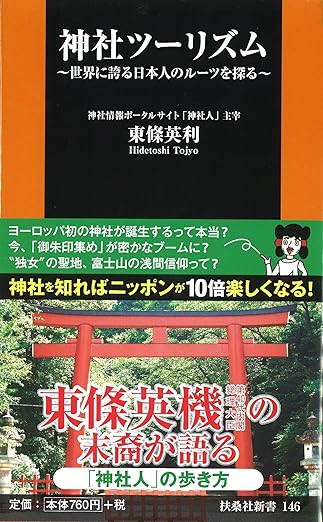"Reading 'Shrine Tourism' is a must for Japanese students aspiring to study abroad or pursue international oppor

"Reading 'Shrine Tourism' is a must for Japanese students aspiring
to study abroad or pursue international opportunities."

"Mr. Tojo, who always writes our columns, has recently published his second book, so I decided to read it promptly.
The author, Mr. Hidetoshi Tojo, is someone I know personally. He manages the portal site 'Jinjajin,' dedicated to shrines, and has walked to over 1000 shrines, creating a database with his own feet. With the support of like-minded individuals who share Tojo's vision, a database for over 80,000 shrines nationwide has been created, accumulating data from around 10,000 shrines. Tojo's humble personality attracts many supporters, leading to a quiet boom, particularly in his lectures.
Shrines have played a significant role in various life milestones such as Hatsumode, Shosai, Shichi-Go-San, coming-of-age ceremonies, weddings, etc. Understanding the essence of these shrines and conveying it to others is one of the purposes of this book.
Given my frequent interactions with international students due to my work, I have always been interested in how to convey Japanese culture to them. Also, having initiated student interpreter volunteer activities based at Meiji Shrine, I find the attempt to introduce Japan using shrines very appropriate.
When volunteering to guide foreigners at Meiji Shrine, I noticed their consistent amazement at Japan's 'purification culture.' Phrases like 'God doesn't appear in dirty places' and 'The sun god is watching' are key explanations of the Japanese culture.
Moreover, the origins of holidays like National Foundation Day and Labor Thanksgiving Day, and even cultural elements like sake and sumo, trace back to Shinto and shrines. Indeed, shrines embody the essence of Japanese culture.
Shrines are found in every town, and even a common local shrine, with proper guidance, can become an impressive tourist spot full of 'Japanese wonders' for foreigners. 'Shrine Tourism' reminds us Japanese that 'ordinary Japan' is our greatest cultural heritage, and it encourages readers to carry it in their bags, read it repeatedly, and turn it into living knowledge. I hope they share what they've learned in various languages with their friends. Foreigners interested in Japan will listen to your stories with interest and respect your ability to articulate them eloquently. (Global Community Editor-in-Chief, Keimi Miyazaki)
Amidst the enduring trend of 'Power Spot Tours,' this year marks the once-in-sixty-years relocation of Ise Grand Shrine and Izumo Taisha. Additionally, Mount Fuji, the sacred mountain of the Asama faith, has finally achieved its long-awaited recognition as a World Cultural Heritage site. Truly, 2013 can be called the 'Year of Shrines.'
However, as Japanese people, are we perhaps too 'ignorant' about our roots, namely shrines and Shinto? Why is being 'clean' considered one of the national traits of the Japanese? Does the spirit of valuing 'public' in Japanese culture stem from the influence of phrases like 'The sun is watching'?
Moreover, is Shinto really a 'religion'? Descendant of the 40th Prime Minister Tojo Hideki, the author, who manages the shrine portal site 'Jinjajin,' reflects on the history built by predecessors and proposes a new form of 'Shrine Tourism,' enjoying 'shrine visits through affiliation and blessings. He delves into the charm of Japan as a 'Cultural Nation.'"
Chapter 1: Japan's Common Sense, the World's Uncommon Sense
Chapter 2: Rules of Shrines
Chapter 3: Shinto and Animism
Chapter 4: "Japan Original" Gods
Chapter 5: Origins of Shrines Ise and Izumo
Chapter 6: The Arrival of Buddhism and the Presence of Shinto
Chapter 7: Mystery Under the Name of "Mythology"
(Shrine Person Operator, Representative of Culture J, Ltd., Hidetoshi Tojo)
Hidetoshi Tojo was born in 1972 in Saitama Prefecture and is the representative director of Culture J, Ltd. He is the direct descendant of Hideki Tojo and the 18th head of the family. Exploring a unique social welfare model in Japan, he turned his attention to the presence of shrines and Shinto. Advocating for cultural tourism through shrines, he aims to revitalize new local communities and cultural entertainment.
1: "What is True Culture? Understanding Japan"
2: Real Meaning of Foundation Day of Japan as a Nation
3: There is a great leap forward after overcoming a crisis.
4: Let's return to the spirit of "Mottainai"!
5: "Understanding Japan's Obon Festival"
6: "The Pink Book for Fulfilling the Whims of Adult Women"
7: "The cultural roots of Japanese New Year
8:Rekindling the Spirit of Herbivore Men Through Taiko Drumming?
9: "Publishing 'Proof of Japanese Identity' - Column by Hidetoshi Tojo, No. 10"
10: "Publishing 'Proof of the Japanese' - Part 2 - Hidetoshi Tojo's Serial Column No. 11"
11: "For the Japanese, What Does 'Work' Mean? - Hidetoshi Tojo's Serial Column No. 12"
12: Learn from the keen insights of our predecessors – Hidetoshi Tojo's Column No.13
13: Japanese Language Quirks: Logographic and Phonetic Characters
14: "What Does 'Shikinen Sengu' Mean to the Japanese? - Hidetoshi Tōjō's Column No. 15"
15: Cultivation Required in a Global Society? - Column by Hidetoshi Tojo, No.16"
16: "Publication of 'Shrine Tourism'!! Hidetoshi Tojo's Serial Column No. 17"